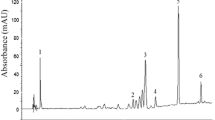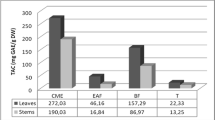Summary
A thin-layer chromatography–2,2-diphenyl-1-picrylhdrazyl (TLC—DPPH) method has been developed for the quantification of withanolides and simultaneous estimation of antioxidant potential of each constituent present in a complex mixture. High-performance thin-layer chromatography (HPTLC) of withanolide-rich fraction of Withania somnifera root was performed on Si 60F254 HPTLC plates with dichloromethane-toluene-methanol-acetone-diethyl ether (6.5:7:4:1.5:1, v/v) as a mobile phase for the separation of withanolides and on the basis of RF values 0.07, 0.55, 0.61, 0.63, 0.66, and 0.77 for withanoside V, withaferine A, 1,2-deoxywithastramonolide, withanone, withanolide A, and withanolide B, respectively. The concentrations of withanoside V, withaferine A, 1,2-deoxywithastramonolide, withanone, withanolide A, and withanolide B were 0.86, 12.9, 1.92, 1.52, 5.24, and 4.52 mg g−1 respectively. A TLC-DPPH rapid test was used to assess the free-radical scavenging activity of constituents in withanolide-rich fraction for the first time. In withanolides, withanoside V and withanolide B show the highest antioxidant potential. In unknown compounds, peak No. 17 at RF 0.92 has the highest antioxidant potential and peak No. 16 at RF 0.87 has recorded the lowest antioxidant potential. It is also found that some of the unidentified components had significant antioxidant potential. This technique has several advantages; therefore, this method will be useful for rapidly validating the Ayurvedic products containing W. somnifera.
Similar content being viewed by others
References
S. Kulkarni, A. Dhir, Prog. Neuropsychopharmacol. Biol. Psychiatry 32 (2008) 1093–1105.
L.C. Mishra, B.B. Singh, Altern. Med. Rev. 5 (2000) 334–346.
G. Gupta, A. Rana, Pharmacogn. Rev. 1 (2007) 129–136.
V. Mehrotra, S. Mehrotra, J. Microbiol. Biotechnol. 1 (2011) 40–45.
S. Bhattacharya, A. Muruganandam, Pharmacol. Biochem. Behav. 75 (2003) 547–555.
J.N. Dhuley, Phytother. Res. 15 (2001) 524–528.
S.K. Gupta, I. Mohanty, Mol. Cell. Biochem. 260 (2004) 39–47.
P. Senthilnathan, R. Padmavati, Chem. Biol. Interact. 159 (2006) 180–185.
S.K. Kulkarni, K.K. Akula, Indian J. Exp. Biol. 46 (2008) 465–469.
M. Ziauddin, N. Phansalkar, J. Ethnopharmacol. 50 (1996) 69–76.
V. Senthil, S. Ramadevi, Chem. Biol. Interact. 167 (2007) 19–30.
J. Dhabheliya, S.A. Khan, Int. J. Pharm. Sci. 2 (2010) 51–53.
A.A. Elberry, F.M. Harraz, J. Basic Clin. Pharm. 1 (2010) 247–254.
P. Pawar, S. Gilda, BMC Complement. Altern. Med. 11 (2011).
A. Singh, V.A. Saharan, Int. J. Green Pharm. 5 (2011) 69–74.
V.S. Sumantran, A. Kulkarni, J. Biosci. 32 (2007) 299–307.
S. Ghosal, J. Lal, Phytother. Res. 3 (1989) 201–206.
M. Ali, M. Shuaib, Phytochemistry (Oxford) 44 (1997) 1163–1168.
M.H. Mirjalili, E. Moyano, Molecules 14 (2009) 2373–2393.
R.S. Sangwan, N.D. Chaurasiya, Physiol. Plantarum 133 (2008) 278–287.
S. Chatterjee, S. Shrivastava, Phytochemistry 71 (2010) 1085–1094.
N.D. Chaurasia, G.C. Uniyal, Phytochem. Anal. 19 (2008) 148–154.
V. Sharma, B. Singh, Chromatographia 66 (2007) 801–804.
P. Shrivastav, N. Tiwari, J. AOAC Int. 91 (2008) 1154–1161.
S.T. Devkar, Y.S. Badhe, J. Planar Chromatogr. 25 (2012) 290–294.
S.M. Suryapujary, R.D. Deotale, J. Soils Crops 20 (2010) 39–41.
A. Kumar, M. Kaul, Genet. Resour. Crop. Evol. 54 (2007) 655–660.
S. Devkar, M. Hegde, Pharm. Biol. (submitted for publication).
L. Misra, P. Lal, Steroids 73 (2008) 245–251.
B. Patwardhan, R. Mashelkar, Drug Discov. Today 14 (2009) 804–811.
L. Ciesla, D. Staszek, Phytochem. Anal. 22 (2011) 59–65.
L. Ciesla, M. Hajnos, J. Planar Chromatogr. 24 (2011) 295–300.
M. Olech, L. Komsta, Food Chem. 132 (2012) 549–553.
O.N. Pozharitskaya, S.A. Ivanova, Phytochem. Anal. 19 (2008) 236–243.
L. Ciesla, D. Staszek, Med. Chem. 8 (2012) 102–111.
R.A. van Iterson, Drenthe College Emmen, Holland, for http://www.standardbase.com.
M. Waksmundzka-Hajnos, J. Sherma, Thin Layer Chromatography in Phytochemistry, CRS Press, Boca Raton, 2008.
T. Kobuyama, C. Tohda, Br. J. Pharmacol. 144 (2005) 961–971.
K. Kour, A. Pandey, Int. Immunopharmacol. 9 (2009) 1137–1144.
F. Malik, J. Singh, Life Sci. 80 (2007) 1525–1538.
P.B. Mohan, A. Hamza, Chem. Biol. 14 (2007) 623–634.
E.P. Sabina, S. Chandel, J. Pharm. Pharm. Sci. 11 (2008) 46–55.
N. Sen, B. Banerjee, Cell Death Differ. 14 (2007) 358–367.
H. Yang, G. Shi, Mol. Pharmacol. 71 (2007) 426–437.
N. Nakayama, C. Tohada, Neurosci. Res. 58 (2007) 176–182.
M. Hegde, S. Bhalerao, Curr. Sci. 95 (2008) 721–722.
Author information
Authors and Affiliations
Corresponding author
Rights and permissions
About this article
Cite this article
Devkar, S.T., Jagtap, S.D., Katyare, S.S. et al. Estimation of Antioxidant Potential of Individual Components Present in Complex Mixture of Withania somnifera (Ashwagandha) Root Fraction by Thin-Layer Chromatography—2,2-Diphenyl-1-Picrylhdrazyl Method. JPC-J Planar Chromat 27, 157–161 (2014). https://doi.org/10.1556/JPC.27.2014.3.2
Received:
Accepted:
Published:
Issue Date:
DOI: https://doi.org/10.1556/JPC.27.2014.3.2




